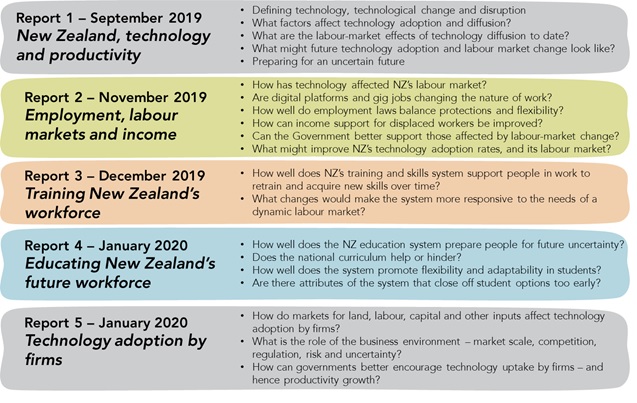Draft reports
Technological change and the future of work
The Commission released five draft reports: Technology adoption by firms, Educating New Zealand's future workforce, Training New Zealand's workforce, Employment, labour markets and income, and New Zealand, technology and productivity.
1 001 New Zealanders' attitudes to tech
Are New Zealanders afraid of robots and AI? We surveyed 1 001 New Zealanders about their attitudes to tech and compared them to attitudes in the EU. Some useful observations can be made:
- Seventy-one percent of New Zealanders responded that the current impact of the most recent digital tech was positive on their own quality of life. Yet New Zealanders are, overall, much more negative than people in EU countries about the effects of emerging tech on the economy and on society.
- New Zealanders are very positive, relative to people in EU countries, about the quality of their own digital skills – applied to their daily life, their use of digital services, and their current and futures jobs.
- New Zealanders’ attitudes to robots and AI are somewhat mixed. They are relatively negative about socially positive uses of robots (eg, to perform dangerous tasks), yet relatively unconcerned that robots would “steal peoples’ jobs”.
- New Zealander’s responses to most questions did not vary much by age. However, older New Zealanders are less confident than younger ones that their digital skills are sufficient for a hypothetical future job.
- New Zealanders with incomes less than $50K showed less favourable attitudes to digital tech than those earning more than $50K. This effect was particularly pronounced in responses to the statement “robots steal people’s jobs”. There was little difference between those earning $50–100K and those earning above $100K.
- Just 40% of New Zealanders believe that New Zealand is keeping up with the best in the world when it comes to the digital transformation of industry.
Read the report: New Zealanders' attitudes towards robots and AI.
Technology adoption by firms
Our fifth draft report, Technology adoption by firms, deals with the policies to encourage technological adoption. Decisions about whether and how to adopt technology are taken by individual firms. Many factors influence these decisions, but three important drivers are relative prices, risks, rewards and management capability. Government policies and infrastructure affect firm technology adoption decisions, sometimes in unexpected or unintended ways.
Protecting and extending business environment dynamism should be a priority of any government seeking to encourage technology adoption. There are some specific areas where government action could help remove barriers to, or increase the rewards for, technology adoption. These are discussed in the report.
Subject choice for the future of work
To support our report on Educating New Zealand’s future workforce, the Commission contracted the New Zealand Council for Educational Research to look at the ways in which secondary schools can help or hinder students’ ability to make choices for an uncertain future of work.
The research (divided into two parts: insights from the literature, and insights from focus groups), identifies a number of relevant issues. These include the continued existence of a “well-lit pathway” from school to university, the constraint that University Entrance can place on student choices, and the way in which patchy implementation of the New Zealand Curriculum’s key competencies can limit students’ ability to keep their options open. Read both reports here:
Educating New Zealand’s future workforce
In our fourth draft report, Educating New Zealand’s future workforce, the Commission looks at how the New Zealand education system could better prepare young learners for the world of work.
The report found that alternative pathways into work are obscured by the more “well-lit” pathway towards university. In schools, timetabling constraints and regulatory requirements (especially those related to University Entrance) mean that vocational pathways receive less attention, respect and resources. Careers advice in schools is highly variable. The tertiary system makes it hard for students to change course as they learn more about their preferences and the opportunities open to them. Students bear high costs from making initial mistakes or from changing their minds.
There are opportunities for improvement to be made in the current reforms to the education system. The report identifies opportunities to improve the promotion of innovation and good practice across the education system; support better curriculum implementation; remove constraints on students’ ability to pursue relevant learning and career pathways; improve students’ ability to switch in tertiary education; and address digital inclusion for young people.
Training New Zealand’s workforce
In our third draft report, Training New Zealand’s workforce, the Commission looks at how work-related education and training can support a more dynamic labour market.
In the context of the Government’s current reforms of the vocational education and training system, the Commission found that more system flexibility is needed to meet the education and training needs of people in the workforce and for those soon to join it.
Specific recommendations focus on widening access to work-based education and training, reducing barriers to providing credentials that help labour-market dynamism, and making it easier to move money around the tertiary education system in response to demand. Find out more:
Employment, labour markets and income
In our second draft report, Employment, labour markets and income, the Commission looked to other countries for answers to help promote technology adoption. We found countries with policies that promote income security over job security – known as ‘flexicurity’ – tend to be more open to technology adoption. In this draft report, we outlined three options for improving income security in New Zealand:
- Introducing portable individual redundancy accounts
- Mandating unemployment insurance
- Making changes to benefits and tax credits
The research reports commissioned for this report are: Measuring the gig economy, Occupational drift in New Zealand, The impacts of job displacement on workers by education level, and Unemployment insurance what can it offer NZ?
Technology and productivity in New Zealand
Our first draft report New Zealand, technology and productivity looked at the factors affecting technology adoption and how technological adoption affects the labour market. It also examined how technology affected work in the past, including in New Zealand. We found that:
- There is little evidence in the available data that widespread disruption to work is coming soon.
- The likely pace and scale of technological change in New Zealand will depend to a significant extent on developments overseas.
- Technology and labour-market trends in New Zealand tend to lag behind those overseas, and will be more muted, if recent history is anything to go by.
- The main problem facing New Zealand today isn’t too much technology, it’s not enough. New Zealand needs to embrace technology, not treat it as a threat.
Find out more, read:
Series of draft reports
The Commission has released five draft reports to address different aspects of this inquiry’s terms of reference:

Key documents
-
Draft report 5 - Technology adoption by firms
31 January 2020
-
Draft report 4 - Educating New Zealand's future workforce
22 January 2020
-
Draft report 3 - Training New Zealand's workforce
20 December 2019
-
Draft report 2 - Employment, labour markets and income
21 November 2019
-
Draft report 1 - NZ, technology and productivity
-
A3 briefing - Draft report 5
-
A3 briefing - Draft report 4
-
A3 briefing - Draft report 3
-
A3 briefing - Draft report 2
-
A3 briefing - Draft report 1
-
A3 briefing - NZ, technology and productivity
Research
-
Insights from focus groups - NZCER
-
Insights from research literature - NZCER
-
Measuring the gig economy - Motu
-
New Zealanders' attitudes towards robots and AI
-
Summary of micro-credentials roundtable
-
The impacts of job displacement on workers by education level - Motu
-
Unemployment insurance what can it offer NZ? - Kathy Spencer

